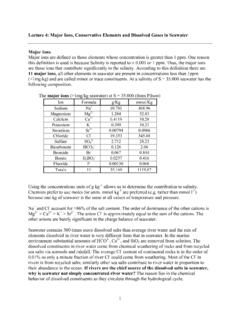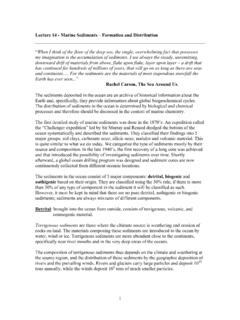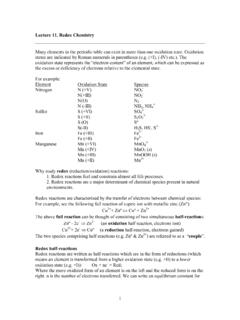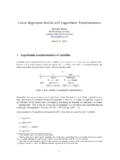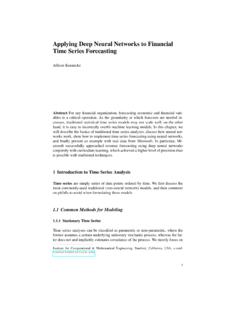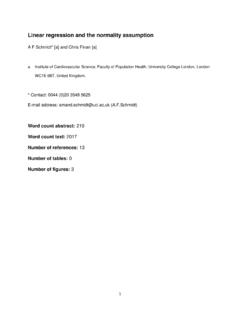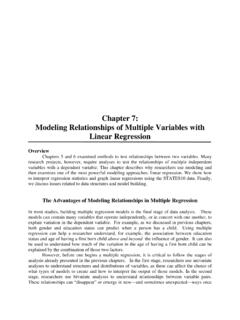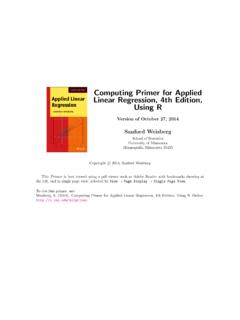Transcription of Lecture 6: Mass Balance - The Cornerstone of Chemical ...
1 1 Lecture 6: mass Balance - The Cornerstone of Chemical Oceanography The Chemical distributions on the earth and in the ocean reflect transport and transformation processes, many of which are cyclic. The cycling of water from the ocean to the atmosphere to land and back to the ocean via rivers is such an example. This basic cycling is often described in terms of the content of the various reservoirs ( , the ocean, the atmosphere, etc.) and the fluxes between them ( , evaporation, rivers, etc.). A fundamental question is how the rates of transfer between the reservoirs depend on the content of the reservoirs and on other external factors. The details of the distributions within the reservoirs are, for the most part, neglected.
2 Most oceanographers construct simple models to test their understanding of the essential elements of the system and to predict the response of a system to perturbations and forcing. The two main types of models used. These are: Box (or reservoir) Models and Continuous Transport-Reaction Models First some basic definitions related to models in general and box models in particular. model A simplified or idealized description of a particular system or process that is put forward as a basis for calculations, predictions or further investigation. A model should contain only those elements of reality that are needed to solve the problem. A model is an imitation of reality that stresses those aspects that are assumed to be important and omits all properties considered nonessential.
3 Parameter A quantity that is constant in a particular case considered, but which varies in different cases. Variable A quantity or force that, throughout a mathematical calculation or investigation, is assumed to vary or be capable of varying in value. Closure Closure in a modeling sense usually means having the number of unknowns equal the number of equations. Often, closure is achieved by making simplifying assumptions. Reservoir or Box (M) The amount of material contained by a defined physical regime, such as the atmosphere, the surface ocean or the lithosphere. The sizes of the reservoirs are determined by the scale of the analysis as well as the homogeneity of the spatial distribution.
4 The units are usually in mass of moles. Flux (F) Amount of material transferred from one reservoir to another per unit time. Source (Q) A flux of material into a reservoir. Sink (S) A flux of material out of a reservoir Budget A Balance equation of all sources and sinks for a given reservoir. Residence Time or Turnover Time ) The ratio of the content of a reservoir (M) divided by the sum of its sources Q) or the sum of its sinks S). Thus, = M/ Q or = M/ S. Cycle A system consisting of two or more connected reservoirs where a large fraction of the material is transferred through the system in a cyclic fashion. Budgets and cycles can be considered over a wide range of spatial scales from local to global.
5 2 Steady State When the sources and sinks are in Balance and do not change with time. Closed System When all the material cycles within the system Open System When material exchanges with components outside the system. mass Balance Simple Box Models Many processes may act to control the distributions of chemicals in the ocean. The method of putting these processes together in a model utilizes the principle of mass Balance applied to the system as a whole or some parts of it (control volumes). The system as a whole is linked to the environment by external inputs and outputs. Box models are especially useful for understanding geochemical cycles and their dynamic response to change.
6 Describing a model first requires choosing a system; that is, the division between what is "in" and what is "out". The second step involves choosing the complexity of the description of the "internal" system (how many components in the system). The goal in modeling is to analyze all the relevant processes simultaneously. The concept of mass Balance serves as a way to link everything together. To use the idea of a mass Balance , the system is first divided into one or several "control volumes" which are connected with each other and the rest of the world by mass fluxes. A mass Balance equation is written for each control volume and each Chemical The Change in mass with Time = Sum of all Input Sources + Sum of Internal Sources Sum of Outputs Sum of all Internal Sinks Such box models are used to determine the rates of transfer between reservoirs and transformations within a reservoir.
7 Advantages are: 1. It is easy to conceptualize where material is coming from and where it is going. 2. Provide an overview of fluxes, reservoir sizes, and turnover or residence times ). 3. They provide the basis for more detailed quantitative models. 4. They help identify gaps in knowledge. Disadvantages are: 1. The analysis is superficial and over-simplified. 2. Little or no insight is gained into what goes on inside the reservoirs or into the nature of the fluxes between them. 3. They usually assumes homogeneous average distributions within reservoirs 4. They can easily give a false impression of certainty, even if all the individual fluxes have solid estimates.
8 Remember, a model is an imitation of reality. 3 Steady State and Residence Time We can draw a one box model of the ocean with the main fluxes indicated. These include river and glacial input, atmospheric exchange, hydrothermal exchange, radioactive activity, and sediment exchange. Rivers and glaciers are shown here as ocean sources. The other fluxes can go both ways. The total dissolved mass in the box is called M and is assumed to be homogeneously distributed in the box. Simple 1-Box Ocean Atmosphere dn/dt Rivers (+dn/dt) Glaciers (+dn/dt) Sediments Hydrothermal At steady state the dissolved concentration (Mi) does not change with time: (dn/dt)ocean = dni / dt At steady state the sum of the sources (dni/dt)sources must equal the sum of the sinks (dni/dt)sinks.
9 For most elements the main sources are from continents via the atmosphere and rivers. Removal to the sediments is a main sink for most elements. Hydrothermal processes can be both sources and sinks depending on the element. The following Balance is a good approximation for most elements in the ocean: (dm/dt)ocean = F atmosphere + F rivers F sediments F hydrothermal If we assume steady state then the change with time is zero or dMi / dt = 0. Residence Time ( The residence time (also called turnover time) is defined as the ratio of the dissolved mass in a reservoir divided by the mass flux in or out of the reservoir. For example, using a simple model with one source and one sink, can be thought of as the time it would take to fill the reservoir if the source (Q) remained constant and the sink was zero (or vice-versa).)
10 = mass / input or removal flux = M / Q = M / S Example: Q [M] S Q = input rate ( , moles yr-1) S = output rate ( , moles yr-1) [M] = total dissolved mass in the box (moles) Radiodecay dn/dt dn/dt dn/dtMi 4 Residence time can also be calculated with respect to any one of the individual fluxes (Qi or Si) as well, again with all other sources and sinks at zero. For example, you could calculate the residence time of Fe in the ocean with respect to input from either the atmosphere or rivers. The rate of change equation for this simple model is the difference between the source(s) and the sink(s), thus: d[M] / dt = Q - S If the inflow rate equals the outflow rate, or Q = S, then d[M] / dt = 0 and we would have steady state A zeroth order flux means that the flux is not proportional to how much M is present in the one-box ocean.
